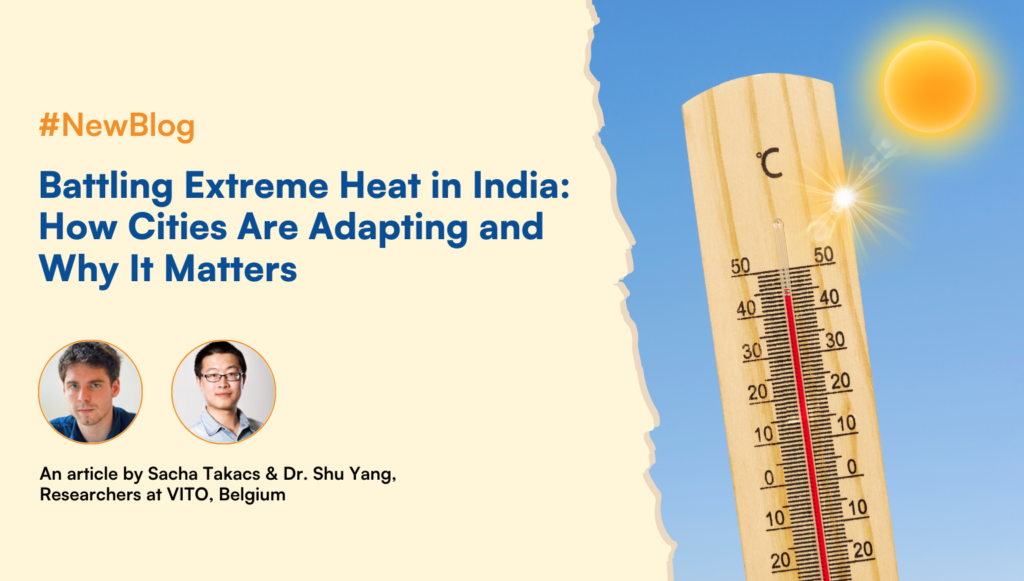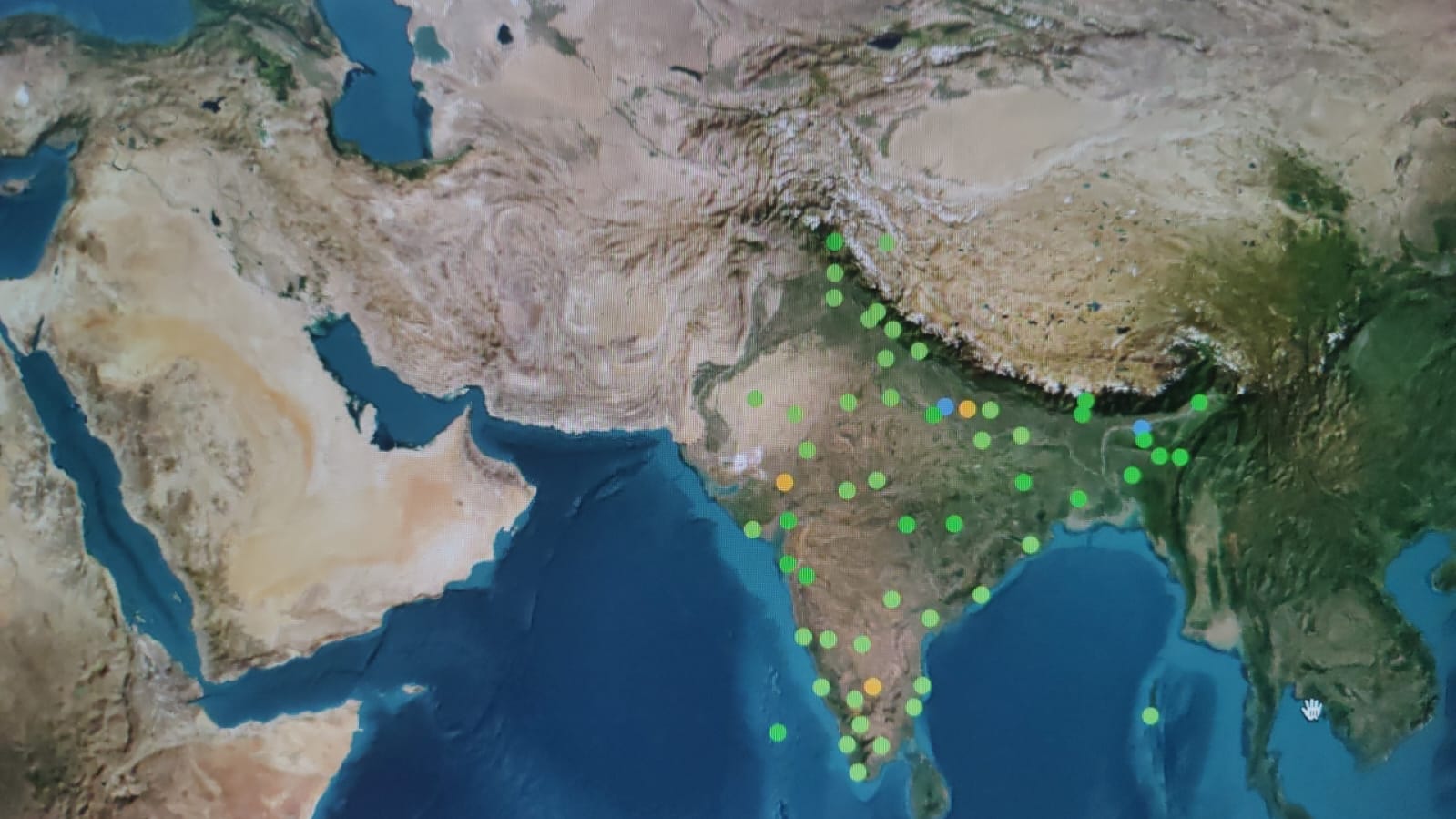
The planet is warming. Global temperatures are projected to rise by 3.2°C by the end of the century, and heatwaves are intensifying even under a 1.5°C warming scenario [1]. In India, mid-century temperatures are projected to rise by 1.6°C to 2.2°C, surpassing the global average [2]. Heat exposure has remained a “hidden hazard”, with less visible impacts than floods or earthquakes, yet it disrupts urban life, increases mortality, reduces productivity, and strains infrastructure [3],[4],[5]. It poses serious health risks, especially for vulnerable groups like older adults, children, and those with chronic conditions, worsening cardiorespiratory issues, mental health disorders, kidney injuries, and dehydration [4],[5], which will be further amplified by climate change, particularly in tropical regions.
The Study: A High-Resolution Look at Three Indian Cities
In a recent effort to better quantify the scale of potential heat impacts, researchers used the UrbClim model [6]. at a resolution of 100 meters to capture temperatures in three Indian cities, i.e. Lucknow, Chennai, and Surat [7]. This model incorporated data from 2001 to 2020 (present) and also looked ahead to 2041–2060 under two emission scenarios: a low-emission scenario (SSP1-1.9) and a high-emission scenario (SSP3-7.0). The researchers combined the climate model’s output with epidemiological data linking extreme heat to mortality [8]. and productivity losses [9],[10]. This allowed them to develop a systematic approach to estimate future climate impacts – accounting for population growth – under both a “no-adaptation” scenario and scenarios “takin into account” four specific adaptation measures: cool roofs, increased vegetation, heat early warning systems, and shifting outdoor work hours to cooler periods.
Measuring Impact Without Intervention
The research team considered two main channels of heat-related losses: excess mortality linked to temperature increase and reduced labor productivity estimated using the Wet Bulb Globe Temperature index (WBGT – a heat stress index – which captures not only air temperature but also solar radiation, wind speed, and humidity).
Drawing on time-series studies that relate daily temperatures to mortality [8], they estimated that current heat-related deaths range from 0.2 to 0.4 per thousand inhabitants per year in the three cities (see Figure 1a). By 2050, this could increase by up to 50% in a high-emissions scenario. In real numbers, that means Chennai might see over 8,700 annual heat-related deaths, with Lucknow and Surat around 4,000 each when population growth is incorporated. People over 70 years old are especially vulnerable; their rate of heat-related mortality is about 20% higher than the general population.
The paper also examined lost productivity using the WBGT index [9],[10].Currently, around 20% of annual work hours in these cities are considered unsafe for high-intensity physical work. By mid-century, that proportion could reach 30–40%, leading to billions of dollars in annual losses and affecting up to 4% of urban GDP (see Figure 1 and c). In Lucknow and Chennai, where a large portion of the workforce is engaged in outdoor labor, productivity losses due to extreme heat could be particularly severe.

Figure 1: Heat-related excess mortality and economic loss projections by 2050. (a) Heat-related excess mortality in present-day and 2050 under low (SSP1-1.9) and high (SSP3-7.0) scenarios. (b) Economic loss from labor productivity (% of GDP). (c) Economic loss in billions of USD (2020 values). Error bars show the range over 20-year periods. Source: Jones et al. 2024
Four Adaptation Strategies
Based on the literature review, the study identified four interventions that stand out for their efficacy and practicality: urban greening, heatwave early warning systems, cool roofs, and shifting work hours. Each was explored in medium- and high-ambition “packages” incorporating the costs of implementation and the benefits measured through saved lives, productivity gains, and lower energy expenses (for cool roofs).
(1) Urban Greening
Expanding tree canopies in cities has a cooling effect on local climate. In the three-city analysis, every 10% increase in tree coverage brought average air temperatures down by roughly 0.43°C. Applying a high-ambition target of 30% additional tree cover could reduce heat-related excess mortality by about 35% by 2050. This intervention also improves labor productivity by slightly lowering the WBGT for outdoor workers. The study found that the costs of planting and maintaining trees, around 2.50 USD per tree plus 5 USD in annual maintenance [11], appear modest in comparison to the projected benefits. Even without factoring in co-benefits like flood mitigation and psychological well-being, trees’ benefit-to-cost ratio (BCR) ranged from 2:1 to 5:1 (see figure 2).
(2) Heatwave Early Warning Systems
A well-planned early warning system includes real-time monitoring, alerts, and targeted outreach to vulnerable groups [4]. Drawing on experiences in Ahmedabad [12] and global best practices, the researchers posited that a medium-ambition system could cut heat-related deaths by 20%, while a high-ambition version reduces them by 40%. Because the initial and operational costs are relatively small, the BCR surpassed 50:1. For Chennai, a robust early warning system might save between 1,400 and 3,500 excess deaths annually by 2050, depending on emission levels. These results position heatwave alerts and responsive healthcare capacities as a top priority for cost-effective adaptation.
(3) Cool Roofs
Experiments in India have shown that simple lime washes (natural white paint) or high-density polyethylene (HDPE) membranes can reduce cooling energy usage in buildings by 14–26%. The study found that applying such coats to 25% of city rooftops yields a BCR of around 3:1 just from energy savings, assuming each square meter saves about 17 kWh in cooling [13] More complex interventions, such as reinforced concrete roofs with added coatings, carry higher installation costs and may not show the same favorable return. Despite that limitation, cool roofs remain an attractive solution—particularly as air conditioning use continues to grow in many Indian cities, a trend that not only expels heat into the environment and raises outdoor temperatures but also strains the power grid during heatwaves.
(4) Shifting Working Hours
Restructuring the workday to avoid midday heat is among the simplest concepts. The research showed that a two-part daily schedule—from 6 AM to 11 AM, then 3 PM to 7 PM—could recover 5–15% of currently lost productivity for high-intensity outdoor jobs. If half of outdoor workers in Lucknow adopted this “early morning – late afternoon” schedule, around 20 million USD in economic losses could be averted annually by 2050. While logistical and cultural concerns may complicate such schedule shifts, the theoretical BCR of over 50:1 underscores its efficiency. Certain Middle East countries already – such as the UAE – have implemented midday work bans for part of the year, indicating that with enough policy support, shifting hours is both viable and highly beneficial.
Which Adaptations Work Best?
Heatwave early warning systems provide the highest economic returns, delivering over $50 in benefits for every dollar spent in some scenarios. Global examples affirm the effectiveness of these strategies. Heat early warning systems, like those in Madrid and Philadelphia, have achieved BCRs exceeding 50:1 [14] [15].Urban greening and cool roofs also show strong potential, with benefit-cost ratios (BCRs) between 2:1 and 5:1, and around 3:1, respectively. Urban greening, jas also proven in Europe to reduce heat-related deaths by 20% with a 30% increase in tree cover [16]. Moreover trees offers additional benefits, including improved flood resilience and mental health. Together, these interventions demonstrate the potential for practical, high-impact solutions to mitigate heat risks in a warming world. While adjusting work hours could theoretically yield high returns, implementation challenges must be considered. Combining these interventions maximizes impact: green infrastructure cools cities, early warnings save lives, cool roofs reduce energy costs, and adjusted work hours protect laborers—all reinforcing urban resilience to heat.

Figure 2: Benefit-to-cost ratio for all identified heat adaptation measures. Source: Jones et al. 2024
Expanding Urban Heat Adaptation Insights
Heat adaptation studies in India now extend beyond the three cities discussed, with the UrbClim model applied to over 50 cities to examine the combined effects of climate change and urban growth on heat stress [17]. These efforts deepen understanding of how diverse urban areas experience and respond to extreme heat. Publicly accessible data from these studies enable policymakers and planners to design targeted, context-specific interventions, supporting scalable and inclusive adaptation strategies nationwide.

Challenges and Limitations
Some limitations arise from the lack of data easpcially for instance the difficulty of attributing health outcomes to heat. The researchers used nationwide temperature-mortality curves, which may overlook local variations, and their productivity calculations focused mainly on outdoor work, potentially leaving out the effects of high indoor heat. Urban greening also relies on having adequate space, water resources, and proper tree maintenance. Moreover, although the study quantified the impact of trees on mortality, it did not capture multiple other benefits—such as improved flood absorption, local job creation, and enhanced mental well-being—that likely add to the total value of greening. Despite these constraints, this research provides a valuable starting point for integrating climate modeling, with impact modelling and adaptation planning to evaluate their cost-effectiveness, bridging three fields that have long remained separate in the literature.
Ways Forward
While this study underscores the benefits of targeted heat adaptation strategies, much work remains to address the growing threat of extreme heat. Future research must integrate high-resolution climate models with socio-economic parameters to provide localized assessments of heat impacts. Developing city-specific temperature-mortality curves, incorporating indoor heat exposure data, and analyzing cascading effects on key sectors will yield a more comprehensive understanding of risks.
Scaling up adaptation measures requires stronger institutional coordination, public engagement, and investment. Publicly accessible data should guide equitable, context-specific interventions, while strategies like urban greening and early warning systems must address resource and maintenance challenges.
Integrating heat adaptation into broader climate resilience and urban development plans is critical. By fostering collaboration among governments, researchers, and communities, scalable and cost-effective solutions can be developed, ensuring a resilient response to extreme heat.
This blog post is based on insights from our World Bank Policy Research Working Paper. You can access the full paper here:
https://documents.worldbank.org/en/publication/documents-reports/documentdetail/099304410282418477/idu14636d4df1ab37144601857917779c8690438
